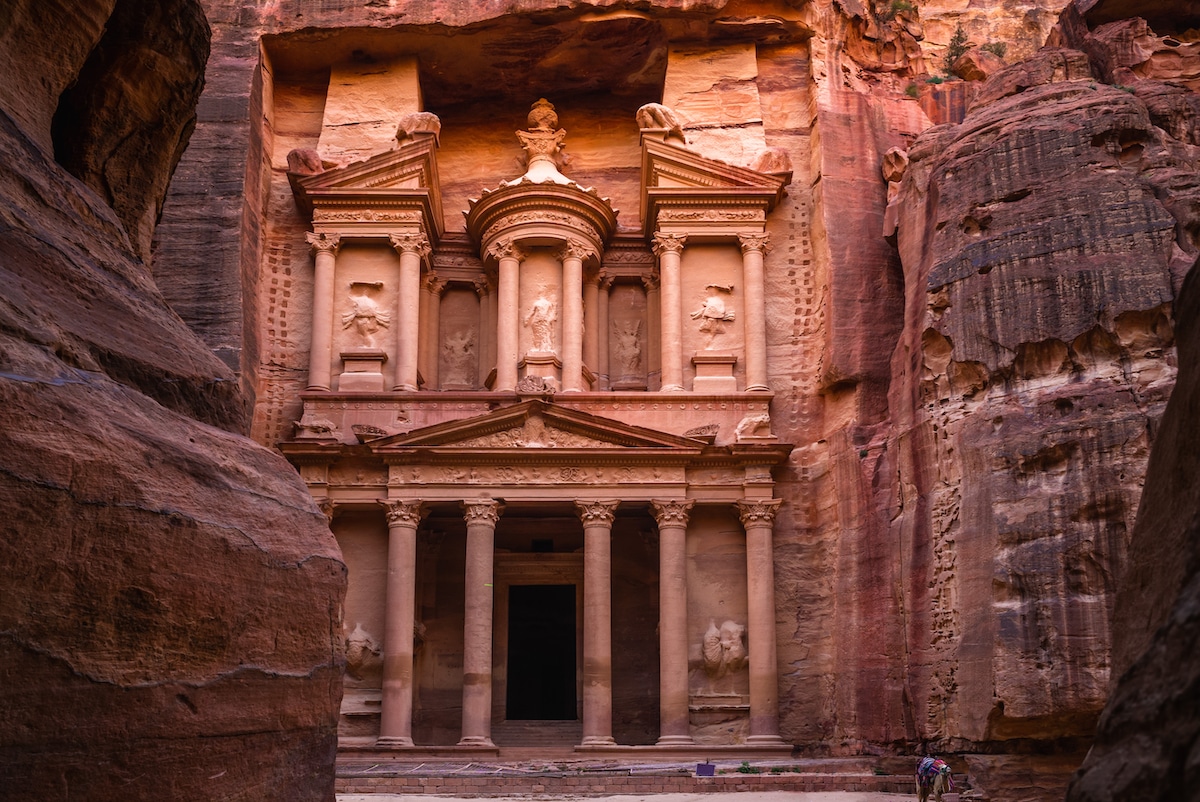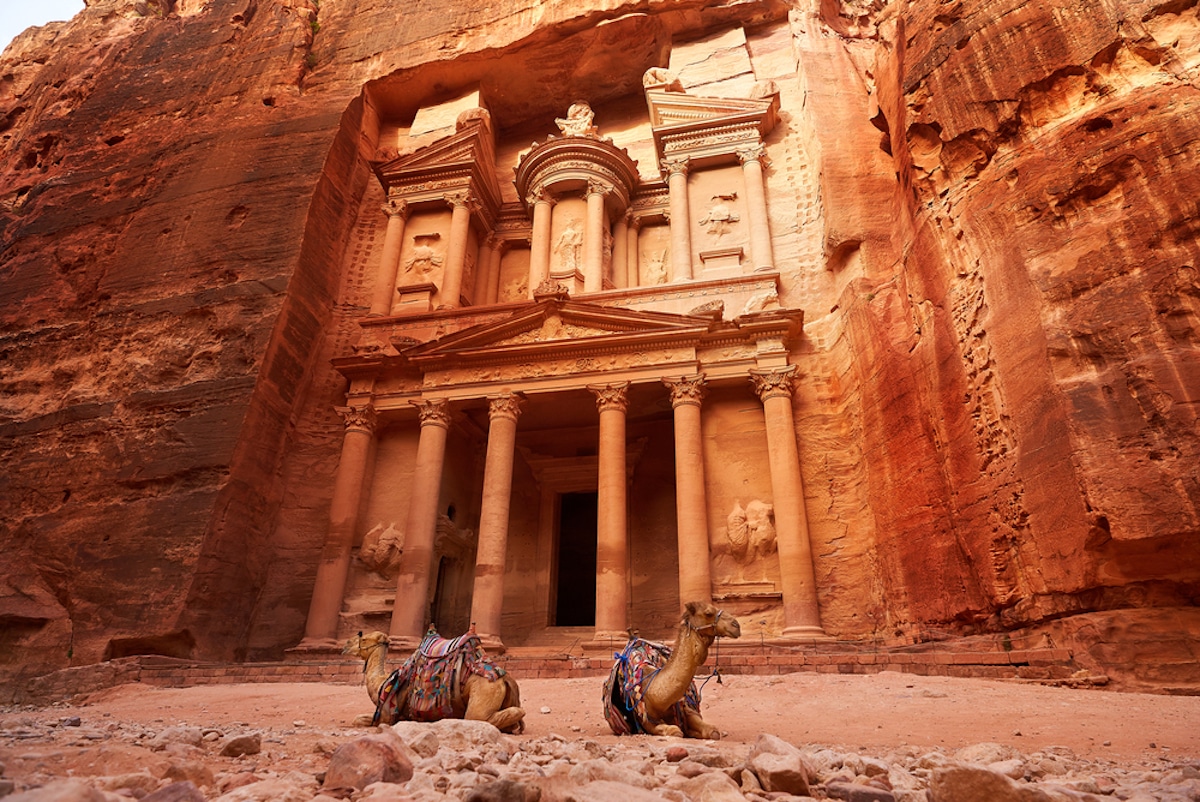The prehistoric metropolis of Petra, also known as the Rose City, is an astonishing sight that must be seen to be believed. It is also a World Heritage Site. In the fourth century BC.E, the city was founded and was once a major commercial centre. Its architecture, which is carved into the red-sandstone-cliffs, has contributed to its designation as one of the New Seven Wonders of the World. Petra, located in the desert canyons of southwestern Jordan, was the ancient Nabataean civilization’s capital and is now a museum.
Petra, which covers an area of 102 square miles, is a spectacular monument that attracted more than one million visitors last year alone. Surprisingly, what we see today represents only a fraction of the treasures that this historic city has to offer. Archaeologists have only excavated 15 percent of the site, which means that an incredible 85 percent of it is still buried beneath the earth’s surface.
Even if you have never been to Petra, you are likely familiar with it because of its appearance on the silver screen. A variety of films, including Indiana-Jones & the Last Crusade, The Mummy Returns, and Aladin, have used the country’s distinctive archaeology as a setting.

When visitors arrive at Petra today, they will find themselves on the same path that traders and visitors have taken since the site’s founding thousands of years ago. The Siq, a long, winding gorge, serves as a prologue to the wonders that lie beyond. The three-quarters-mile long trip, which translates to “the shaft,” creates anticipation for what is ahead. The route is embellished with carvings of a camel and niches that would have housed Baetylus—sculptural representations of gods—as well as other decorations.
Even though it appears to be a long walk to get to the main action, it is definitely worth the effort to take it all in. The first glimpse of Petra’s renowned architecture will appear within a short period.
The Nabataeans

There was once a nomadic Bedouin tribe called the Nabataeans that travelled the Arabian desert and built the city of Petra. They rose to prominence as a political force between the 2nd and 4th century BCE. They immediately set about constructing their capital, which we now know as Petra. Raqmu, on the other hand, was not the city’s original name; the Nabataeans referred to it as Raqmu instead.
Because of its dominance over a commercial network vital to the ancient world, Nabataean culture prospered and remained stable for thousands of years. A result of their involvement in international trade, they were exposed to and inspired by various civilizations from the Mediterranean and Arab nations. It is believed that these influences were absorbed into their religious beliefs and culture.
It is a spectacular symbol of their wealth and power, located in Petra. It was once home to a population of 30,000 people. The city was difficult to conquer because of its strategic location. Once the Romans defeated the Nabataeans, it only grew in size due to their conquest. The influence of Roman architecture can be seen all around Petra, including the Treasury.
Despite being absorbed into the Roman kingdom in 106 CE, the Nabataean kingdom continued to exist for several centuries after that. But gradually, they fell into squalor for reasons that weren’t entirely apparent. Their territory was divided among other Arab kingdoms to make way for other people.
The Rediscovery of Petra

Following the eighth century CE, Petra was virtually abandoned. Even though nomadic shepherds continued to utilize the constructions as shelter, the structures remained unknown to the rest of the world for more than a thousand years. All of that changed in the nineteenth century when Swiss explorer Johann Ludwig Burckhardt “found” the ruins of the city of Carthage.
In Syria, Burckhardt was studying Arabic when he came across the story of a German-explorer who had been murdered while searching for the hidden city of Petra. Burckhardt decided to go and investigate the report. Burckhardt was determined to track down the treasure. He adopted the alias Sheikh Ibrahim Ibn Abdallah to conceal his true identity as he set about assimilating himself into society. In the aftermath of several years in Aleppo, he felt confident enough to go on the trek to Cairo, hoping to pass through the ruins along the way.
On his route to Aqaba, he travelled through Jordan’s interior when he came across reports of ancient remains in the local area. Given that this corresponded with what he’d previously learned about Petra, he pretended that he wanted to sacrifice his goat and asked his local-guide to accompany him to the tombs to perform the ritual. At this moment, he was escorted across the Siq and, as a result, became the first Westerner to see Petra, which occurred in 1812.

When he arrived at his destination, “an excavated mausoleum came into view, the situation and beauty of which are calculated to make an extraordinary-impression upon the traveller, after having traversed for nearly half-an-hour such a gloomy and almost subterraneous-passage as I have described,” he wrote in a book about his journey. The authors’ testimony in Reland’s Palestina indicates that the ruins of Wady Mousa are those of the ancient city of Petra, and it is noteworthy that Eusebius claims the grave of Aaron. Was shewn near Petra.” At the very least, based on all of the information I’ve gathered, I’m convinced that there is no other ruin between the Dead Sea and the Red Sea that is of sufficient significance to rival that city.” “I’m convinced that there is no other ruin between the Dead Sea and the Red Sea that is of sufficient importance to rival that city.”
Many Western explorers visited Petra following Burckhardt’s spectacular discovery to produce drawings of the structures and study the city’s architecture. This cleared the path for its natural beauty to be recognized worldwide.
Al Khazneh

The Treasury, also known as Al Khazneh, is one of Petra’s most recognizable monuments. It is carved into the face of red sandstone rock and rises to a height of 127 feet and spans almost 82 feet in width. It is located at the most significant entrance into Petra from the Siq. The rich decoration on it emphasizes the significance of its location. It is almost Hellenistic in style. It is adorned with floral and figurative design and architectural components like columns and pediments reminiscent of ancient Greek temple architecture.
Despite the fact that the monument is known as the Treasury, it is actually a tomb. Archaeologists are almost convinced that it was the burial of a Nabataean king or queen, based on its conspicuous position in the landscape. Unfortunately, because no coins or ceramics have been discovered that could provide clues to the mystery’s solution, we still do not know the exact period of its creation or for whom it was constructed. But King Aretas IV, who reigned in the period between 9 BCE and 40 CE, is the most plausible candidate. As the most successful ruler of the Nabataeans, he reigned when Petra was at its zenith and many of the city’s buildings were under construction.

Considering that the site is a tomb, what exactly is the relevance of the phrase “Treasury”? The Bedouins became convinced that the urn on the second floor contained the treasure of an Egyptian Pharoah during the early twentieth century, when the urn was discovered. The truth is, they were so positive that they continued to fire at it in the hopes of unleashing the hidden riches… Following that, the moniker remained in place. In Indiana Jones & the Last Crusade, Al Khazneh is shown as the location of the Holy Grail, which is regarded to be one of the world’s greatest treasures and is depicted as the location of the Holy Grail in Indiana-Jones & the Last Crusade.
Millions of visitors come to Petra each year to take in the spectacular architecture and marvel at the prehistoric civilization that made such a lasting influence on the world.







